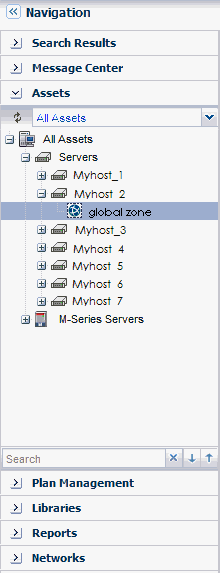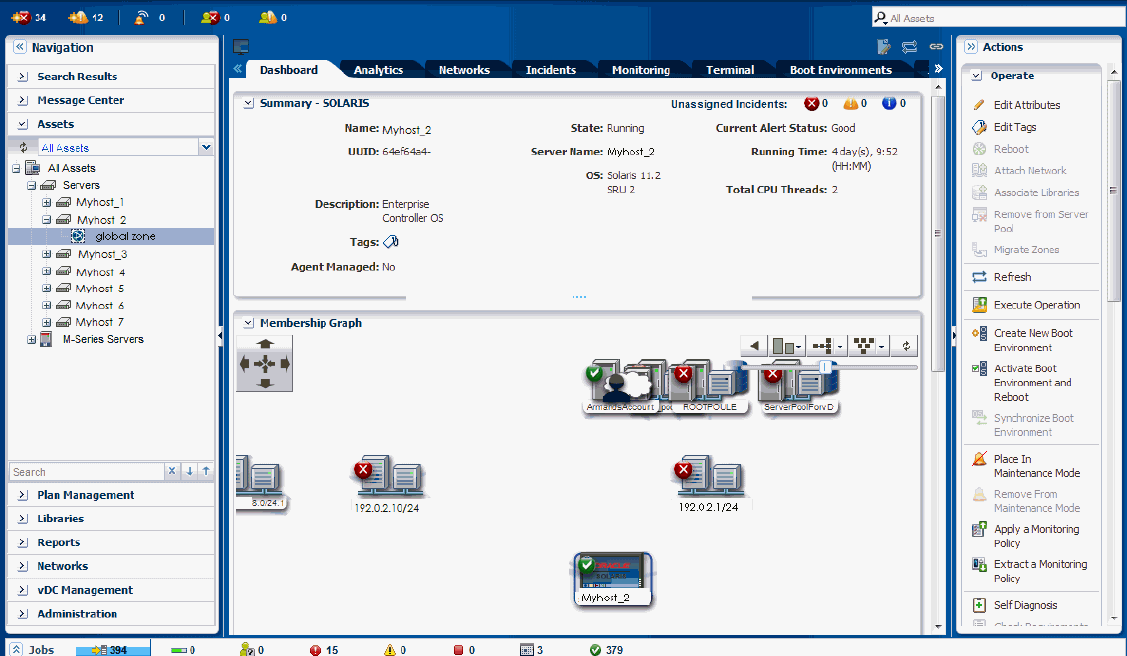Navigation Pane
The Navigation pane contains the following sections:
-
Message Center: Message Center displays and manages incidents, generates notifications, displays service requests, and the warranty information of an asset.
-
Assets: Assets list all the assets of Oracle Enterprise Manager Ops Center. Assets display standard views, user-defined groups, and resource management views. In the case of server pools, Assets also governs the virtualization hosts' placement and migration, and the server pool's networks and storage.
-
Plan Management: Plan Management displays Deployment Plans and Profiles that install, provision, and update one or more servers in Oracle Enterprise Manager Ops Center. It also displays Monitoring Policies, Operational Plans, Incidents Knowledge Base, and the credentials that are used in Oracle Enterprise Manager Ops Center.
-
Networks: Networks display all the networks that are discovered, declared, and created in Oracle Enterprise Manager Ops Center. It also displays discovered fabrics.
-
Libraries: Software libraries stores images and operating system updates components (policies and profiles). Storage libraries list different NAS, iSCSI, and FC storages that are known to Oracle Enterprise Manager Ops Center.
-
Reports: Reports lists the various types of reports that you can create, such as Operating System Reports, Incident Reports, and Firmware Reports.
-
vDC Management: vDC Management contains and manages a set of physical resources, and makes them available as virtual resources to virtual datacenter accounts.
-
Administration: Administration performs administrative functions, such as user administration, logs, and the status of service, including the version and upgrades available for the Agent.
Only the Administrator of Oracle Enterprise Manager Ops Center can access the Administration section. The administrator can change any configuration for the Enterprise Controller, Proxy Controllers, LDAP directories, users, and so on.
Click the right-arrow next to the section title to open the section and see its available resources and options. You can open only one section at a time. Figure 3-6 shows the Assets section of the Navigation pane.
Figure 3-6 Assets Section of Navigation Pane

Description of "Figure 3-6 Assets Section of Navigation Pane"
When a new asset is discovered, or when a job or a task is completed, the information changes in Oracle Enterprise Manager Ops Center, and the user interface refreshes automatically. When you do not see the new asset in the Assets pane, click the Refresh symbol in the Asset section of the Navigation pane to get the latest lists of assets. Similarly, click the Refresh symbol in the Jobs pane to view the latest list of jobs.
Oracle Enterprise Manager Ops Center, manages the Asset section of the Navigation pane that lists all the assets grouped by its type. You can choose one of the following views to see the lists of assets.
-
Standard Views: Use the All Assets view to display all managed assets of every type. To filter the view to display one type of asset, use one of the other standard views: Operating Systems, Chassis, and Servers. Click the plus symbol to expand the associated assets.
-
Resource Management Views: Use Resource Management View to filter the assets in the form of Server Pools, Storage, Racks, Oracle Solaris Cluster, and Oracle Engineered Systems.
-
User Defined Groups: Use the User Defined Group to filter the assets according to user definitions. When you create a group, this customized list becomes the new default view. A list shows a hierarchy of assets.
An icon represents the status of each asset. These icons distinguish one type of asset from another type. A quick scan of the asset hierarchy displays the servers that have a Linux operating system or an Oracle Solaris operating system, and also finds any unconfigured assets.
In an Asset hierarchy, an incident associated with an asset is notified by a badge that appears next to the asset icon. Badges show the current status of each asset like running, shutdown, locked, and suspended. When the incident is of a high priority in the membership group, the badge appears next to the parent asset in the asset hierarchy. The system removes the badge after the incident is acknowledged, marked repaired, or closed. A badge is displayed in the asset tree for proxies that do not have any agent configured.
Note:
Badges are special types of icons that describe the type of incident associated with the asset.
Along with the assets, the Navigation pane displays all other elements such as, plans and profiles, networks, libraries of images and data, reports, and administrative functions. Expand the right arrow on the title bar to view the hierarchy of these items.
The center pane displays information according to your selection in the Navigation pane. The center pane is where you do most of the work. To increase the size of the center pane, close the Navigation pane. Click the left double-arrow in the title bar of the Navigation pane, to collapse the pane. To select another asset, expand the Navigation pane again by clicking on the right double-arrow.
For example, when you select the Server node of Assets section in the Navigation pane, the center pane displays the information about the Managed Members, and Unmanaged Members. Under the Server node, when you select a server, the center pane displays information about the Server's Hardware, Incidents, Service Requests, Rules, Jobs, Configurations, and Summary details. When you select the Operating System in the Asset section of Navigation pane, the center pane displays the Analytics, Incidents, Terminal, Storage, Jobs, Configuration, and the Summary of the Operating System.
Similarly, when you select All Assets node in the Assets section, the Action pane displays options to create, find, and add assets. When you select Server in the Assets section, the Actions pane displays the related actions to Execute Operation, Edit Tags, Refresh and so on. Further selection of the operating system in the Assets section of Navigation pane displays operations related to the operating system, such as Creating New Boot Environment, Executing Operation, Attach New Network, Edit Tags, and Edit Attributes.
Note:
The tabs and information displayed in the center pane and the Actions pane change, depending on what asset is selected in the Navigation pane.
Figure 3-7 shows the details of the assets that appear in the center pane of the user interface of Oracle Enterprise Manager Ops Center.
Figure 3-7 Details of Asset Displayed in the Center Pane

Description of "Figure 3-7 Details of Asset Displayed in the Center Pane"